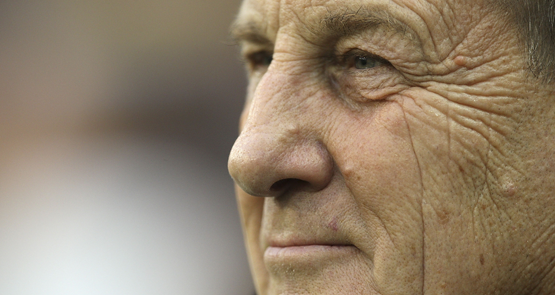Last Tuesday, readers of this space were told of an “eerily upbeat” campaign being waged by the Liberal National Party ahead of Saturday’s Queensland state election, which had no parallel in Australia’s recent political history in its determination to “accentuate the positive”.
What a difference a week makes. In that short time, Premier Campbell Newman has come out swinging haymakers and issuing threats in every conceivable direction — at the opposition, troublesome media figures, and even the voters themselves.
First up was the defamation action lodged on Thursday by Newman and his deputy Jeff Seeney against Alan Jones and Fairfax Radio 4BC, in response to Jones’ apoplectic campaign against the government in the radio segment he has temporarily taken on with the evident intention of harming Newman’s bid for re-election.
Newman then ended the week by declaring Labor guilty until proven innocent of receiving donations from bikie gangs, despite failing to provide evidence to support the claim.
Crowning it all was Newman’s extraordinary observation on Sunday that voters could only expect to see promised projects delivered in their electorates if they had “strong representation from an LNP member”.
It may be that the LNP’s plan all along was to toughen its approach late in the campaign as voters returned to their work routines and tuned back into the news media, after spending the more relaxed part of the post-holiday period softening Newman’s image and priming the government’s main advantage on economic policy.
Certainly the negative advertising the LNP has taken to screening in the past week can’t have appeared out of thin air.
The key television spot depicts a confused tangle of preference arrangements between Labor, the Greens, the Palmer United Party and Katter’s Australian Party, with the payoff that voters should use Queensland’s optional preferential voting system to cut through the confusion and simply vote one for the LNP.
While it takes a bit of work to recognise that the squiggly lines and dreadful voice impersonations are intended to evoke Bob Katter and Clive Palmer, the ad is more or less effective in exploiting existing attitudes, as the most potent political ads usually do (even though its central contention is essentially untrue, as neither KAP nor PUP are directing preferences to any of the other three parties).
However, an alternative explanation for the campaign’s change in atmosphere is that Newman has become rattled by the stickiness of Labor’s competitive poll ratings, carrying with it the spectre of failure in his own electorate of Ashgrove, or perhaps a crossbench big enough to deprive the LNP of a parliamentary majority.
This certainly seems like the most likely explanation for Newman’s threat to withhold projects from electorates that don’t vote the right way.
Those with a stronger grounding in Queensland’s political history tell me that similar things were said in the dark and distant past by Joh Bjelke-Petersen, but the precedent that sprang to my own mind was that of Jeff Kennett at the Victorian election of 1999.
Like Newman today, but without the complication of a struggle to retain his own seat, Kennett went into the election with the almost universal perception that he was on course for a third term. Kennett too had been noted for delivering tough medicine to repair a troubled budgetary position, and was seen by supporters as having injected new vitality into the capital city through such means as a major casino project (albeit that Campbell Newman’s equivalent remains at the planning stage).
Rather than focus on the marginal seats that stood to be decisive in the event of a close race, Kennett spent energy on expanding the Liberal empire into the south-eastern Melbourne centre of Dandenong, where Labor’s traditionally comfortable margins had been cut fine in its successive electoral disasters of 1992 and 1996.
Voters in Dandenong were told their unglamorous patch of outer Melbourne stood to achieve something called “premier city” status, but only if they chose wisely in selecting members for the seats of Dandenong and Dandenong North.
Similarly, voters in Ballarat, who had narrowly returned Liberal members for the city’s two electorates in 1996, were told in no uncertain terms that they were expected to do so again. Otherwise, Kennett warned, they would be “putting at risk whether Ballarat maintains the momentum into the 21st century, or whether it is going to stop in its tracks and see Bendigo and Geelong go ahead in leaps and bounds”.
On a rare campaign visit to Mildura, which had fallen to independent Russell Savage in 1996, Kennett informed locals that the reason they hadn’t seen him in four years was that their community had “chopped itself off at the socks when it voted for Russell”.
Come election day, both Ballarat seats fell to Labor, the Dandenong seats swung solidly against the Liberals, and Russell Savage retained Mildura in a canter. A brace of shock losses throughout regional Victoria cost Kennett his majority, and then the premiership after Savage lined up with two other independents to deliver government to Steve Bracks and Labor.
Whether Queensland voters prove any more accommodating of the Kennett-Newman school of gentle persuasion, only Saturday will tell.









Just came back from the letterbox with a nice glossy black flyer:
“Ready for chaos?” underneath photos of Milne, Ansastasia, The KAT, The PUP and what looks like Lee Marriott from KAT.
That’s it for the front of the flyer, so turn it over to find quotes from the Courier Mail and The Australian warning QLD’ers that “minor parties and independents are meeting to ‘harvest’ preferences.”
Then there is a blurb about all the evils that will beset you if you “number every square” for the minor parties.
This all sounds great but there is nothing on the flyer as who it’s from.
Oh wait – some fine print: “Authorised by B.Henderson. 66-68 Bowen Street, Spring Hill QLD 4000.” B. Henderson must be a rich person to afford to live in a house that spans 66-68 in postcode 4000 and print enough glossy black flyers to spam the entire state.
Cool – I’ll vote for B.Henderson if I see the name on the ballot paper.
Threatening voters is unlikely to endear them to your particular party. If I lived in Queensland, it would have the complete opposite effect on me!
there is no doubt that most queenlanders deserve the newman government, after 32 years of jo,to simply to fall for a party like the L.N.P and put them into government shows they`ve learnt nothing, the same applies to the rest of australia and the abbott government, I hope both governments remain in power for many years and inflict the punishment the stupid voters deserve.